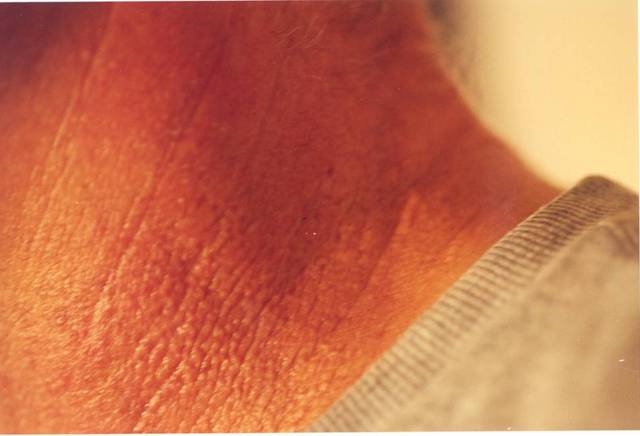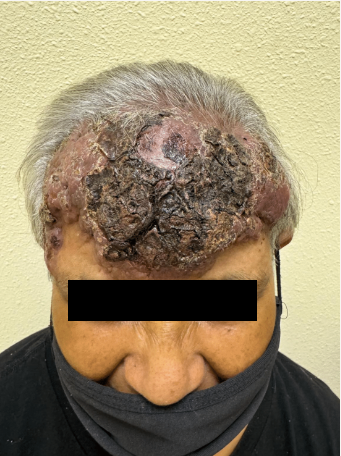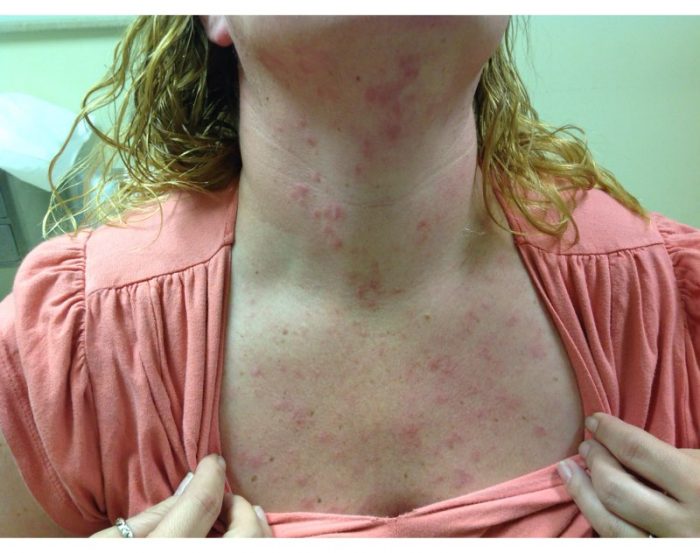CORRECT DIAGNOSIS:
Pseudoxanthoma elasticum
DISCUSSION:
This case was presented to review the characteristic appearance of this relatively rare, inherited disorder involving the connective tissue of the skin, eye, and cardiovascular system. Pseudoxanthoma elasticum (PXE), although usually transmitted in an autosomal recessive pattern, may occur as an autosomal dominant connective tissue disorder. Recent genetic studies have suggested PXE to be linked to mutations in the MRP6/ABCC6 gene, a member of the ABC transporter family. Angioid streaks are the characteristic retinal finding and are due to rupture in Bruch’s membrane secondary to elastic fiber defect. Retinal changes are found in 85% of PXE patients and precede skin changes. Skin findings are soft, yellow coalescing papules with underlying lax, redundant skin, the so-called “plucked chicken skin” appearance. The sides of the neck, groin, and axillae are commonly affected. When a patient experiences both skin and eye changes it is called Gronblad-Strandberg syndrome. Patients occasionally experience involvement of the arteries of the gastric mucosa resulting in gastric hemorrhage. Cardiovascular complications include mitral valve prolapse, hypertension, and accelerated coronary artery disease secondary to degeneration of the elastic fibers in the media of vessels. Patients are noted to have extensive calcification of peripheral arteries causing intermittent claudication.
TREATMENT:
No definitive therapy is available. There might be an association between dietary calcium levels and severity of PXE and therefore patients should be counseled on limiting their calcium intake. Our patient received laser treatment for the angioid streaks. Patient has requested no treatment for his neck findings. Plastic surgery could be a potential option and helpful for loose skin folds.
REFERENCES:
Sherer, D. W., Sapadin, A. N., & Lewohl, M. G. (1999). Pseudoxanthoma elasticum: An update. Dermatology, 199(1), 3–7. https://doi.org/10.1159/000018797 [PMID: 10484770]
Lebwohl, M., Neldner, K. H., Pope, M., et al. (1994). Classification of pseudoxanthoma elasticum: Report of a consensus conference. Journal of the American Academy of Dermatology, 30(1), 103–107. https://doi.org/10.1016/S0190-9622(94)70104-5 [PMID: 8281695]
Ringpfeil, F., Pulkkinen, L., & Uitto, J. (2001). Molecular genetics of pseudoxanthoma elasticum. Experimental Dermatology, 10(4), 221–228. https://doi.org/10.1034/j.1600-0625.2001.100403.x [PMID: 11567040]
Spitz, J. (1996). Genodermatosis. Baltimore: Williams & Wilkins.
Ohtani, T., & Furukawa, F. (2002). Pseudoxanthoma elasticum. Journal of Dermatology, 29(10), 615–620. https://doi.org/10.1111/j.1346-8138.2002.tb00517.x [PMID: 12492853]




